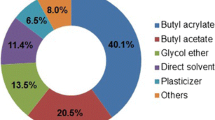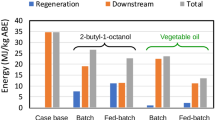Summary
In an effort to improve the viability of acetone-butanol-ethanol fermentation by extractive fermentation, 63 organic solvents, including alkanes, alcohols, aldehydes, acids, and esters, were experimentally evaluated for biocompatibility with Clostridium acetobutylicum by observing gas evolution from cultures in contact with candidate solvents. Thirty-one of these solvents were further tested to determine their partition coefficient for butanol in fermentation medium. The biocompatible solvent with the highest partition coefficient for butanol (4.8), was poly(propylene glycol) 1200, which was selected for fermentation experiments. This is the highest partition coefficient reported to date for a biocompatible solvent. Extractive fermentations using concentrated feeds were observed to produce up to 58.6 g·l−1 acetone and butanol in 202 h, the equivalent of three control fermentations in a single run. Product yields (based on total solvent products and glucose consumed) of 0.234 g·g−1 to 0.311 g·g−1 and within run solvent productivities of 0.174 g·l−1·h−1 to 0.290 g·l−1·h−1 were consistentwith conventional fermentations reported in the literature. The extended run-time of the fermentation resulted in an overall improvement in productivity by reducing the fraction of between-run down-time for fermentor cleaning and sterilization.
Similar content being viewed by others
References
Barton WE (1990) Evaluation and selection of solvents for extractive fermentation using Clostridium acetobutylicum ATCC 824. MSc (Eng) Thesis, Queen's University at Kingston, Ontario
Bruce L, Daugulis AJ (1991) Solvent selection strategies for extractive biocatalysis. Biotechnol Prog 7:116–124
Dawson JR (1986) Studies of the actone, butanol and ethanol fermentation of Clostridium acetobutylicum. MSc Thesis, Queen's University at Kingston, Ontario
Eijs AMM van, Wokke JMP, Ten Brink B (1988) Supercritical extraction of fermentation products. In: Bruin S (ed) Preconcentration and drying of food materials, vol 6. Elsevier, Amsterdam, pp 135–143
Ennis BM, Marshall CT, Maddox IS, Paterson AHJ (1986) Continuous product recovery by in-situ gas stripping/condensation during solvent production from whey permeate using Clostridium acetobutylicum. Biotechnol Lett 8:725–730
Evans PJ, Wang HY (1988) Enhancement of butanol formation by Clostridium acetobutylicum in the presence of decanol-oleyl alcohol mixed extractants. Appl Environ Microbiol 54:1662–1667
Filippi RP de, Moses JM (1982) Extraction of organics from aqueous solutions using critical-fluid carbon dioxide. Biotechnol Bioeng Symp 12:205–219
Inoue A, Horikoshi K (1989) A Pseudomonas thrives in high concentrations of toluene. Nature 338:264–266
Ishii S, Taya M, Kobayashi T (1985) Production of butanol by Clostridium acetobutylicum in extractive fermentation system. J Chem Eng Jpn 18:125–130
Jones DT, Woods DR (1986) Acetone-butanol fermentation revisited. Microbiol Rev 50:484–524
Kollerup F (1986) Ethanol production by extractive fermentation. PhD Thesis, Queen's University at Kingston, Ontario
Kollerup F, Daugulis AJ (1985) Screening and identification of extractive fermentation solvents using a database. Can J Chem Eng 63:919–927
Larrayoz MA, Puigjaner L (1987) Study of butanol extraction through pervaporation in acetobutylic fermentation. Biotechnol Bioeng 30:692–696
Larsson M, Holst O, Mattiasson B (1984) Butanol fermentation using a selective adsorbent for product recovery. In: Verlag-Chemie, Weinheim (eds) Third European Conference on Biotechnology, vol 2, pp 313–316
Maddox IS (1982) Use of silicalite for the adsorption of n-butanol from fermentation liquors. Biotechnol Lett 4:759–760
Mattiasson B, Suominen M, Andersson E, Haggstrom L, Albertsoon P-A, Hahn-Hagerdal B (1982) Solvent production by Clostridium acetobutylicum in aqueous two-phase systems. In: Chibata I, Fukui S, Wingard LB (eds) Enzyme Engineering, Vol 6, Plenum Publishing, New York, pp 153–155
Milestone NB, Bibby DM (1981) Concentration of alcohols by adsorption of silicalite. J Chem Technol Biotechnol 31:732–736
Miller GL (1959) Use of dinitrosalicylic acid reagent for determination of reducing sugar. Anal Chem 31:426–428
Miller TL, Wolin MJ (1974) A serum bottle modification of the hungate technique for cultivating obligate anaerobes. Appl Microbiol 27:985–987
Nielsen L, Larsson M, Holst O, Mattiasson B (1988) Adsorbents for extractive bioconversion applied to the actone-butanol fermentation. Appl Microbiol Biotechnol 28:335–339
O'Brien RW, Morris JG (1971) Oxygen and the growth and metabolism of Clostridium acetobutylicum. J Gen Microbiol 68:307–318
Prescott S, Dunn C (1959) The actone-butanol fermentation. In: Prescott S, Dunn C (eds) Industrial microbiology, 3rd edn. McGraw-Hill, New York, pp 250–284
Rekker RF, Kort HM de (1979) The hydrophobic fragmental constant; an extension to a 1000 data point set. Eur J Med Chem 14:479–488
Roffler S, Blanch HW, Wilke CR (1987) Extractive fermentation of acetone and butanol: process design and economic evaluation. Biotechnol Prog 3:131–140
Roffler S, Blanch HW, Wilke CR (1988) In-situ extractive fermentation of acetone and butanol. Biotechnol Bioeng 31:135–145
Shukla R, Kang W, Sirkar KK (1988) Toxicity of organic solvents to Clostridium acetobutylicum for extractive ABE fermentation. Appl Biochem Biotechnol 18:315–324
Taya M, Ishii S, Kobayashi T (1985) Monitoring and control for extractive fermentation of Clostridium acetobutylicum. J Ferment Technol 63:181–187
Traxler RW, Wood EM, Mayer J, Wilson MP Jr (1985) Extractive fermentation for the production of butanol. Dev Ind Microbiol 26:519–525
Wayman M, Parekh R (1987) Production of acetone-butanol by extractive fermentation using dibutylphthalate as extractant. J Ferment Technol 65:295–300
Author information
Authors and Affiliations
Rights and permissions
About this article
Cite this article
Barton, W.E., Daugulis, A.J. Evaluation of solvents for extractive butanol fermentation with Clostridium acetobutylicum and the use of poly(propylene glycol) 1200. Appl Microbiol Biotechnol 36, 632–639 (1992). https://doi.org/10.1007/BF00183241
Received:
Accepted:
Issue Date:
DOI: https://doi.org/10.1007/BF00183241




